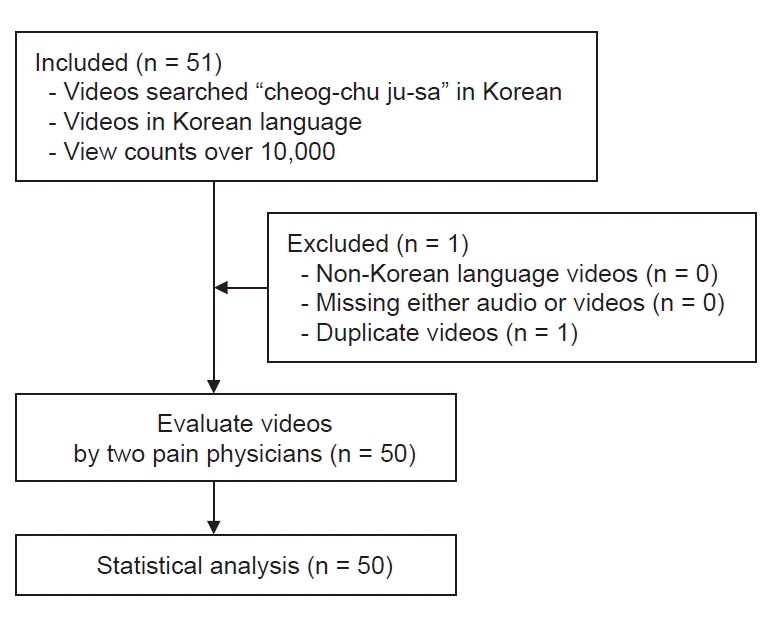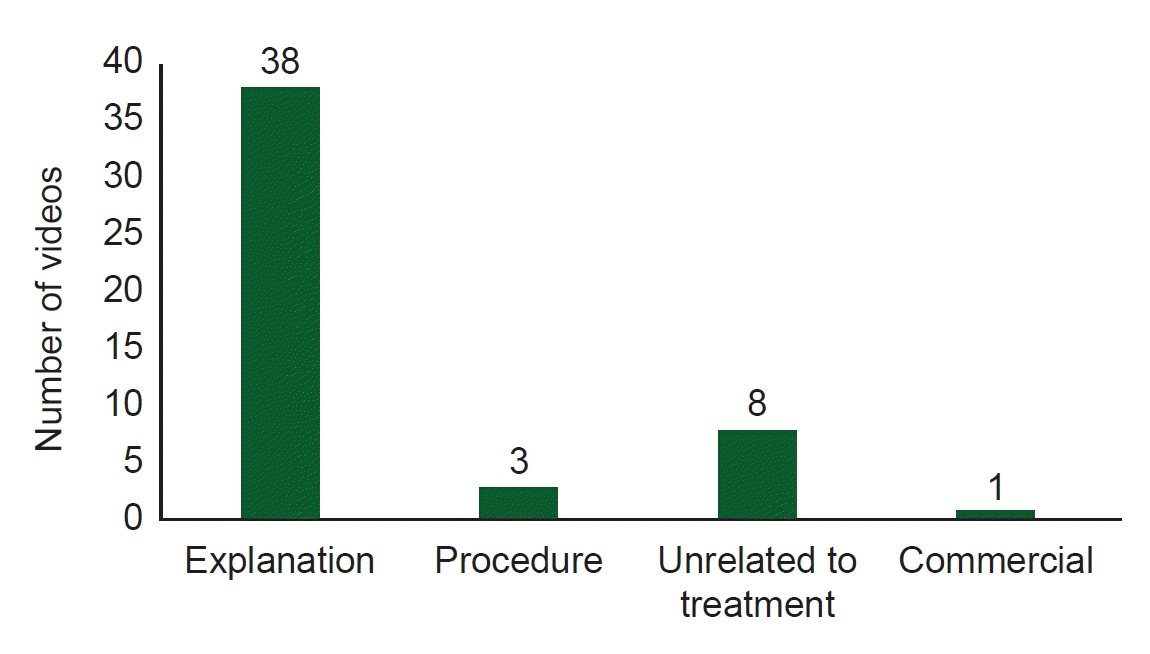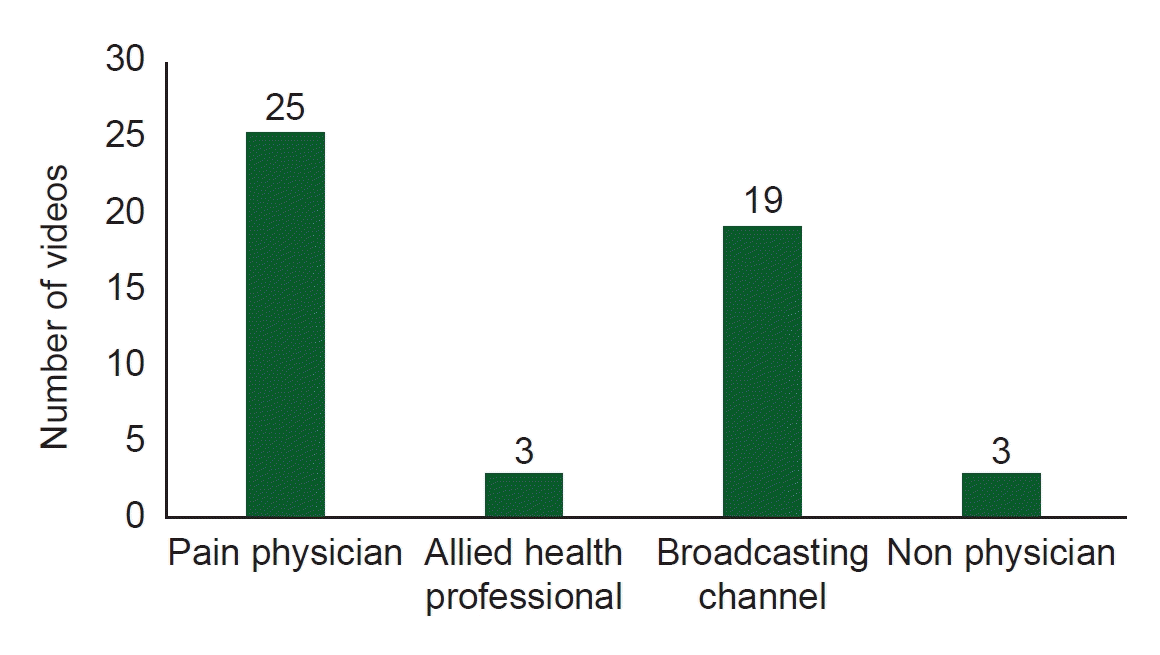This article has been
cited by other articles in ScienceCentral.
Abstract
Background
YouTube, the largest online video platform, has become increasingly popular as a source of health information to patients. The aim of the study was to assess whether Korean patients were well informed about spinal injection from YouTube.
Methods
Search for the keyword “cheog-chu ju-sa” in Korean language was done, and the quality of the 51 videos with the highest number of views was evaluated independently by two pain management doctors.
Results
The averages of global quality scores evaluated by the two doctors were 3.0 and 3.5 and modified DISCERN (mDISCERN) scores were 2.8 and 3.0, respectively. The Kappa statistic between the two doctors’ scores was 0.285 and 0.417.
Conclusions
The percentage of low-quality videos with a global quality score of 2 or less is 18–36%, which indicated that these videos might provide inaccurate or misleading medical information to the patient. Pain clinic doctors should be wary of medically misleading information available on online platforms, such as YouTube, and strive to create and distribute professional quality educational materials.
Go to :

Keywords: Health education, Internet, Patient education, Spinal injection, YouTube
INTRODUCTION
Many people seek medical treatment for back pain. The incidence of people who have experienced neck pain at least once in their lifetime in South Korea is reported to be 20.8–78.3% of the total population depending on age [
1,
2]. More people reported to have experienced low back pain (53.8–81.3%) [
3,
4]. Systemic medication therapy using nonsteroidal anti-inflammatory drugs and opioids, injection therapies using steroids or local anesthetics, exercise therapies, etc. are considered as effective management for chronic low back pain [
5]. Among the injection therapies, epidural injection, facet joint injection, medial branch block, etc. are commonly performed for symptom relief, treatment, and diagnosis [
6–
9].
South Korea ranks No. 1 worldwide in terms of smartphone ownership and internet usage, and people regard digital technology essential in all aspects of life. Eight out of 10 people acquire health information via the world wide web [
10,
11]. YouTube (
http://www.youtube.com) is the largest online video platform and the world’s second-largest internet site with the highest number of daily users. There are more than 2 billion users of YouTube per month, and more than 1 billion videos are views per day. The information available on YouTube is not confined to time and space. Most people search for information on YouTube instead of using search engines such as Google. YouTube is an open platform where any user can upload videos. Although there are many useful videos uploaded by experts and recommended for others to view, there are also instances of inaccurate, commercial videos made by nonprofessionals. Inaccurate or misleading medical information received from world wide web often puts patients at significant risk [
12].
The goal of this study was to evaluate whether YouTube can be a reliable source of information. A qualitative evaluation of information provided by uploaded videos regarding the spinal injection therapy was performed. The videos were searched through a Korean keyword on YouTube. An assessment was made on whether patients living in South Korea were provided with accurate and sufficient information about spinal injection through YouTube uploaded videos.
Go to :

MATERIALS AND METHODS
YouTube search was implemented on June 22, 2021 by creating new accounts. The web browser history was cleared to exclude any recommended videos of previous viewing records by the YouTube algorithm. “Spinal injection (cheog-chu ju-sa)” in Korean characters was the keyword to search. The inclusion criteria were as follows: (1) video with the title and text descriptions in Korean, (2) video that could be viewed by searching the keyword “spinal injection (cheog-chu ju-sa)” in Korean characters, and (3) videos’ view count was 10,000 or more. The exclusion criteria were as follows: (1) video that a Korean-speaking person cannot understand, (2) video missing either audio or video component, and (3) duplicate videos. One of the 51 videos that met inclusion criteria was a duplicate video and excluded from the study. Therefore, the remaining 50 videos were included in the statistics (
Fig. 1).
 | Fig. 1.Clinical trial flow chart. Selection and exclusion of YouTube videos for statistical analysis. 
|
The following points were recorded for each video: (1) the total number of views of the video, (2) the length of the video (seconds), (3) the upload time (months ago), (4) the number of likes, (5) the number of dislikes, (6) the content of the video (i.e., description of disease and back injection procedure, video showing the procedure, video explaining alternative medicine, and advertising video), and (7) producer of the video (i.e., doctor, allied health professional, nonmedical professionals, and professional broadcasting channels).
The quality of the video was evaluated after reviewing each one independently by two pain clinic physicians using the uniform resource locator (URL) links organized in a spreadsheet. Pain physician A had 10 years of medical experience and worked as an anesthesia and pain medicine specialist for 5 years. Pain physician B had 10 years of medical experience and worked as a resident in the department of anesthesiology and pain medicine for 3 years.
The global quality score (GQS) five-point scale described by Bernard et al. [
13] in 2007 on patients with inflammatory bowel disease was used for this study.
Table 1 presents the overall scores of each category.
Table 1.
Global Quality Score Five-Point Scale [
13]
|
Global score |
Global score description |
|
1 |
Low quality, poor flow of video, missing most of the information, not useful to the patient at all |
|
2 |
Generally, low quality and poor flow, some information is listed, but many important topics are missing, so it is of very limited use to patients |
|
3 |
Moderate quality, suboptimal flow, some important information is adequately discussed, while others are missing, somewhat useful for patients |
|
4 |
Good quality and generally good flow, most of the relevant information is listed, however, some topics are not covered, useful for patients |
|
5 |
Excellent quality and excellent flow, very useful for patients |

It was also evaluated using modified DISCERN (mDISCERN), which was used in the qualitative study of consumer health information in Charnock et al. [
14]. mDISCERN consists of five questions: (1) Are the aim and topic clear? (2) Is the source of the information used reliable? (3) Is the information provided balanced without bias? (4) Are additional reference lists provided to patients? (5) Are areas of uncertainty mentioned? If the mDISCERN score is ≥ 3, the information can be considered reliable.
Statistical analysis was performed using SPSS Statistics Version 18.0 (IBM Co., USA). Continuous variables such as the video’s view count, the length of the video, the time the video was made, the number of likes and dislikes were organized by calculating the mean and standard deviation. Cohen’s Kappa coefficient was used to secure reliability for the quality evaluation by the two pain clinic physicians.
Table 2 shows the relative strength of agreement according to the Kappa statistic [
15].
Table 2.
Relative Strength of Agreement According to Kappa Statistic [
14]
|
Kappa statistic |
Strength of agreement |
|
< 0.00 |
Poor |
|
0.00–0.20 |
Slight |
|
0.21–0.40 |
Fair |
|
0.41–0.60 |
Moderate |
|
0.61–0.80 |
Substantial |
|
0.81–1.00 |
Almost perfect |

Institutional Review Board approval was unnecessary for this study because only public access data were used for this study.
Go to :

RESULTS
The total playback time of the 50 evaluated videos was 24,871 s; the average was 497.4 s (standard deviation [SD], 619.7) and the length ranged from 56 s to 4,337 s. The average period for which videos had been posted was 21.1 (SD, 17.8) months, and it ranged from 0 to 98 months. The total number of views of the videos was 5,573,018, with an average of 111,460.3 (SD, 265,516.8), ranging from a minimum of 10,391 to a maximum of 1,261,361. The average number of likes (thumbs up) was 2,600 (SD, 7,779.8), with a minimum of 32 and a maximum of 48,000. The average number of dislikes was 58 (SD, 135.3), ranging from a minimum of 1 to a maximum of 697. The average GQS scores evaluated by two pain clinic doctors were 3.0 and 3.5, respectively, and the standard deviations were 1.3 and 1.4. The Kappa statistic between the two doctors’ GQS scores was 0.285, which indicated a fair strength of agreement. The average mDISCERN scores were 2.8 and 3.0, respectively, and the standard deviations were 1.0 and 0.9. The Kappa statistic between the two doctors’ mDISCERN scores was 0.417, which indicated a moderate strength of agreement (
Table 3).
Table 3.
General Characteristics of Videos
|
Characteristics of videos |
Value |
|
Length of video (s) |
497.4 ± 619.7 (56–4,337) |
|
Posting period (mo) |
21.1 ± 17.8 (0–98) |
|
View counts (n) |
111,460.3 ± 265,516.8 (10,391–1,261,361) |
|
Number of likes (n) |
2,600.0 ± 7,779.8 (32–48,000) |
|
Number of dislikes (n) |
58.0 ± 135.3 (1–697) |
|
GQS score—Physician A |
3.0 ± 1.3 (1–5) (≤ 2 score, n = 17 [34%]) |
|
GQS score—Physician B |
3.5 ± 1.4 (1–5) (≤ 2 score, n = 11 [22%]) |
|
mDISCERN score—Physician A |
2.8 ± 1.0 (1–5) (≤ 2 score, n = 18 [36%]) |
|
mDISCERN score—Physician B |
3.0 ± 0.9 (1–5) (≤ 2 score, n = 9 [18%]) |

About 76% of the videos included contents that explained the process, complications, and progress of the injection procedure. About 16% of the videos explained treatments other than the injection procedure; 6% were videos of the actual injection procedure; and 2% were advertisements regarding injection drugs (
Fig. 2).
 | Fig. 2.Intension of videos. The subject of the video was summarized: explanation 76% (n = 38), procedure 6% (n = 3), topic unrelated to pain clinic treatment 16% (n = 8), advertising purpose 2% (n = 1). 
|
About 50% of the videos were created and uploaded by pain clinic physicians, 38% were created by a professional broadcasting channel or a health specialized broadcasting channel, 6% were made by allied health professionals, non-pain clinic physicians, and 6% of the videos were made by nonphysicians (
Fig. 3). All the uploaded videos by pain clinic physicians revealed the hospital where he or she worked.
 | Fig. 3.Producers of videos. It is a summary of the major creators of the video, with pain doctors 50% (n = 25), allied health professionals such as folk therapists or physical therapists 6% (n = 3), public broadcasting service or medical YouTube channels 38% (n = 19), and nonphysicians 6% (n = 3). 
|
Go to :

DISCUSSION
The percentage of low-quality videos with a GQS score of ≤ 2 was 22–34%. mDISCERN score of ≤ 2 was 18–36%, which indicated that these videos could be misleading or unhelpful to viewers. Only one video in the present study was considered as an advertisement; however, half of the videos (50%) were uploaded by physicians from a local pain clinic who may directly or indirectly operated business. Therefore, the purpose of posting such a video could be considered as advertising.
A study by Chang and Park [
16] evaluated epidural steroid injection on YouTube by searching in English. The average GQS score was confirmed as 2.3 and the average mDISCERN score was 1.5, which was lower than in this study. This difference could be because of the quality of the Korean spinal injection video was higher than that of the English spinal injection video, or could be because the number of Korean videos was remarkably small and there was little interest.
Among the two doctors, the doctor with less experience gave a more favorable score to the video with all. For this reason, a relatively low Kappa concordance was shown, and the Kappa concordance was found to be higher in mDISCERN, which has a more complex evaluation criterion than GQS.
Various attempts have been made to provide effective patient education in all fields of medical departments. In one study on alcoholics, medical staff provided face-to-face education to patients, distributed pamphlets containing relevant information, and installed monitors in the clinic to play informative videos repeatedly. The training was reported to be effective, and the training effects lasted longer after repeated exposure [
17]. In a similar way, adequate and sufficient explanation to patients with back pain not only increased patient satisfaction but also significantly helped with post-treatment managements such as posture correction, stretching and exercise, and weight control [
18]. In view of this, if education can be provided easily and repeatedly using video platforms such as YouTube, it will be certainly helpful for the treatment of back pain.
There are cases in which the disease progressed or worsened as a result of patients misinterpreting medical data arbitrarily collected from the internet [
12,
19]. Another study that evaluated the quality of YouTube videos for patient education regarding hysterectomy concluded that YouTube was not a reliable source because more than half of the videos were of poor quality [
20].
The majority of videos on YouTube provided some useful information and knowledge regarding the disease to patients who had no previous knowledge of spinal injection. However, key information were omitted in most videos. There were also videos that presented biased or unverified opinion about injection treatment, which caused patients to miss the opportunity to receive treatment in a timely manner. It has the potential to give patients the wrong view of spinal injections. Therefore, pain clinic doctors should be wary of medically misleading materials widespread in online platforms such as YouTube and strive to create and distribute better-quality educational materials. If there is a specific video that the pain clinic physician wants the patient to view, one method would be to actively use a quick response code or a URL that can link the video directly to the patient.
Despite the limitations of patient education revealed in studies regarding information through internet media and YouTube, as well as the limitations shown through this study, YouTube contents deliver visual information that is easier for patients to understand and can be played repeatedly. So, the educational potential of YouTube is undeniable.
In conclusion, Korean spinal injection videos uploaded in YouTube seem to have some limitations in providing patient education. We must strive to show high-quality content videos to patients.
Go to :
